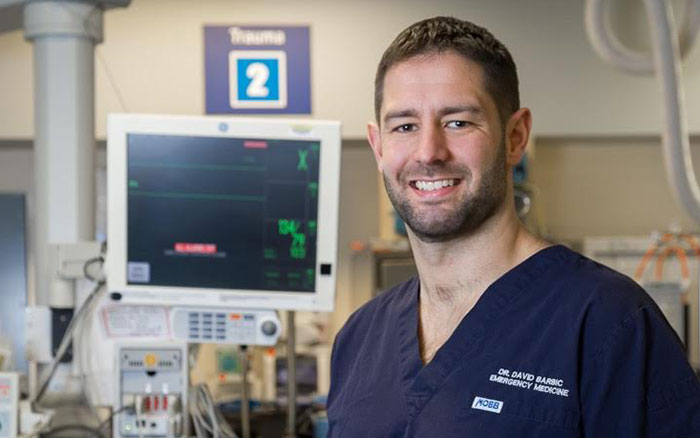
CHÉOS’ newest Scientist is an emergency physician at St. Paul’s hospital and the seventh CHÉOS Scientist who specializes in emergency medicine, joining Drs. Oron Frenkel, Eric Grafstein, Brian Grunau, Garth Hunte, Frank Scheuermeyer, and Rob Stenstrom.
Dr. David Barbic came to St. Paul’s in August 2014 after completing an emergency medicine residency program at McGill and working for one year at Sunnybrook Health Sciences Centre in Toronto. He is also a Clinical Assistant Professor in the Department of Emergency Medicine at the University of British Columbia.
“My research interests can be broken down into two main parts: cardiac resuscitation and vulnerable populations” said Dr. Barbic.
Dr. Barbic has co-authored a number of recent publications with CHÉOS Scientists relating to resuscitation, including three in 2018 alone. One publication which received media attention from The Vancouver Sun and CBC compared rates of bystander CPR and survival after out-of-hospital cardiac arrest (OHCA) in Greater Vancouver neighbourhoods.
“What we found in this study was that a distance to hospital of less than 2.7 kilometers was associated with survival and favourable neurological outcomes,” said Dr. Barbic “We also found that bystander CPR was more common in lower compared to higher median income areas and in areas with the highest percentage of ethnic Chinese residents.”
In his current work, Dr. Barbic is looking at the predictors of survivability and their variation across B.C. with the ultimate goal of improving care province-wide. Some of the variables being explored are urban versus rural residency status, measures of social deprivation, and distance of transport to hospital.
On a national scale, Dr. Barbic is a junior investigator in The Canadian Resuscitation Outcomes Consortium (CANROC). CANROC, which includes Dr. Grunau and Dr. Jim Christenson (UBC Department of Emergency Medicine), is large-scale collaboration between three founding sites: The University of British Columbia, the University ofToronto, and the University of Ottawa. It now includes nine Canadian provinces and will amalgamate existing resuscitation cohorts for a total of 30,000 – 40,000 cases of OHCA. Dr. Barbic’s primary research focus with the Consortium is comparing the survival of patients with OHCA in urban versus rural settings across Canada.
Dr. Barbic’s other research focus is in vulnerable populations and about optimizing care, treatment pathways, and outcomes when they come to the emergency department (ED).
“I’m very interested in improving care for people who are often ignored by the general population and by the health care system” he said.
One such group is older adults. Dr. Barbic is a co-investigator on a study which recently received funding from the CIHR Project Grant program and is based out of McMaster University. The study’s main focus is to produce a clinical decision rule to guide physicians whether CT imaging of the head is needed for seniors who have fallen. There is very little research in this area and there exists a need for clear, concise rules, both to improve diagnosis and to prevent unnecessary scans.
“I’m also interested in improving mental health outcomes in youth who visit the ED” said Dr. Barbic “It’s about connecting youth to the resources they need and to the best care, which may not be found in the ED.”
Dr. Barbic has an upcoming project in the works with Dr. Skye Barbic and the Foundry team. Together they are developing a project to improve ED care and follow up for patients presenting with suicidal ideation.
Finally, Dr. Barbic is the principal investigator of the Rapid Agitation Control with Ketamine in the Emergency Department (RACKED) Study, along with CHÉOS’ Drs. Brian Grunau and Hubert Wong who are co-investigators. The RACKED Study is comparing the effectiveness of intramuscular ketamine to a standard combination of intramuscular medications in patients presenting to the emergency department with agitation and violent behaviour.
“We see patients presenting to the emergency room agitated, aggressive, and with potentially violent behavior every day,” said Dr. Barbic “Intramuscular ketamine may provide a faster and safer way to provide sedation and behaviour control to keep these patients and staff safe.”
On September 26, Dr. Barbic will be presenting in the first Work in Progress Seminar of the 2018/19 schedule where he will discuss the current progress of the trial and thelogistical challenges and feasibility of expanding the RACKED approach, both to a multi-center study and to pre-hospital settings.


